Well-being supports: Overview
The University of Toronto was facing a mental health crisis and students called for reforms. Among the resulting initiatives, I led the vision, coordination and design of a new approach to offering personalized well-being resources via a central service delivery platform.
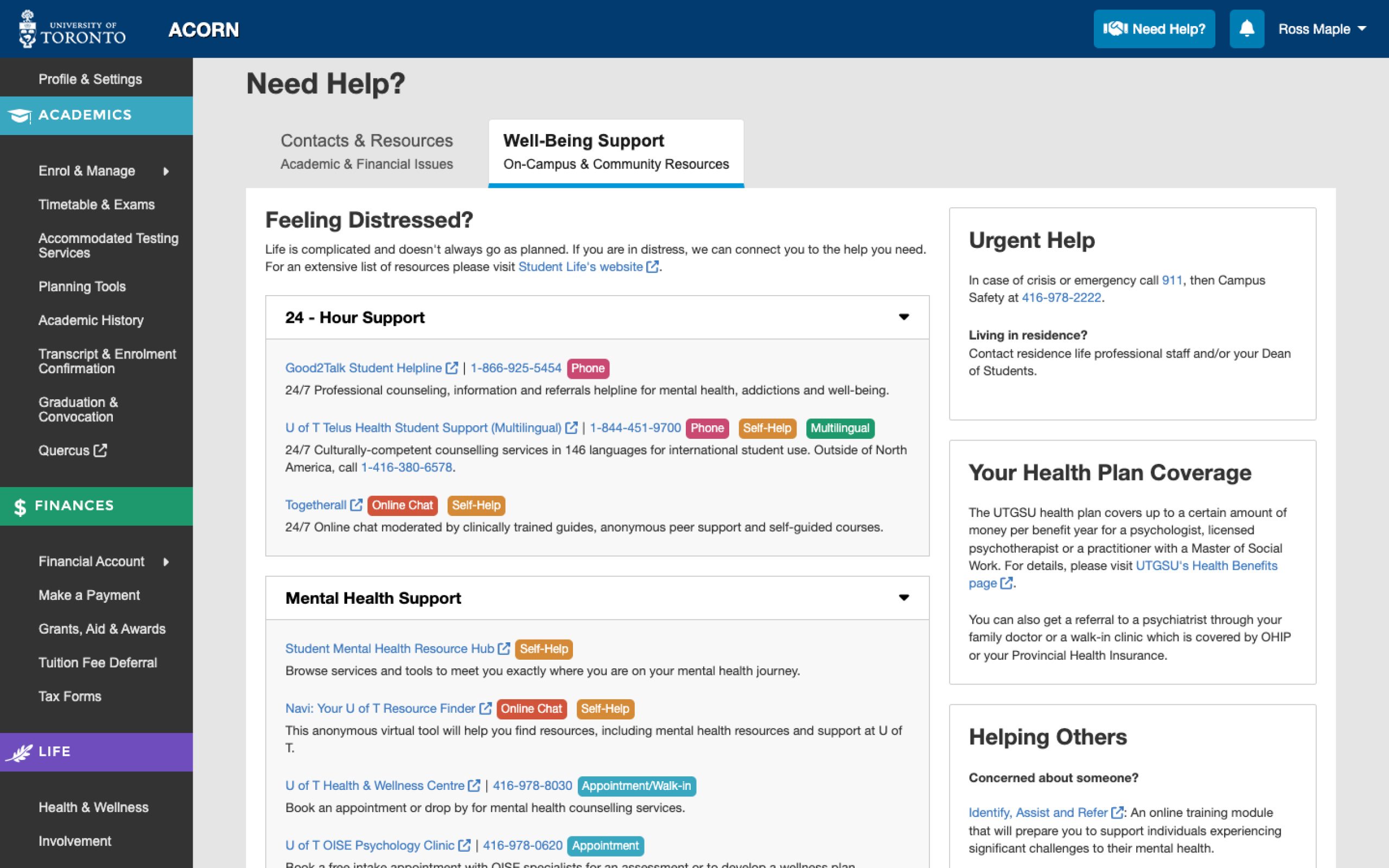
A quick scroll through the default resources (i.e. what a former student or an incoming student without any institutional associations yet would see). These are progressively enhanced for other students based on their registration information.
As the original lead designer and eventual product owner of ACORN, a platform where students sometimes receive disheartening news, I wanted any student who felt overwhelmed in that situation to have immediate access to effective supports.
Well-being supports in ACORN: One part of a university-wide response to a crisis situation
Academic performance and financial obligations are two primary stressors on students at U of T. As the central platform responsible for academic, financial and everyday life matters, ACORN is often the first place students see their grades and invoices.
In moments when a student might feel overwhelmed, I wanted ACORN – with its design tenets of being timely, personalized and helpful – to immediately and helpfully connect them with their available supports.
More than signage encouraging people against self-harm, I intended to improve access to resources for those in need.
Further, I wanted to cut through the clutter of existing resource lists and hard to find external resources by bringing actionable support information directly to students in the space where they may encounter distressing content. I intended to close the gap between a student being in need and their connection with resources that could help.
I envisioned leveraging the personalization capabilities of ACORN’s codebase to help curate the presentation of services that were available to a given student (e.g. on their campus, with their health coverage) along with select other vetted university and public resources.
With a high-level problem established and a plausible solution identified, I began verifying technical feasibility and coordinating long-term viability while I tasked my team with researching relevant student views and behaviours.
Getting to work: Tasks to address the challenge, develop our ideas, and execute a solution
As Manager, User Experience & Process Design, I was responsible for an agile team of 8 practitioners with skillsets emphasizing design, research, analysis, and software development.
My role included planning staff allocations across multiple projects. For this project, I allocated two designers, a talented co-op student to conduct research and design, and a trusted UX designer to oversee their work.
I was also responsible for assessing the technical feasibility of my personalized curation mechanism idea and coordinating with institutional partners to help seed an initial list of resources.
I met with the assigned practitioners for this project at its outset to break down the situation and their tasks: conduct research on current student views and behaviours regarding well-being supports, analyze student mental models of how to best organize that content, research potential well-vetted resources for inclusion, and design the presentation, content and interactions of supports in ACORN (per established design patterns).
Our individual contributions were brought to UX team working sessions and critiques, as well as interdisciplinary ACORN team check-ins to collaborate on, refine and vet our work-in-progress.
Our early research activities generated findings that, in addition to validating that students desired a concise connection to personalized supports, began to inform specific aspects of how those resources could be provided in a desirable fashion.
“There wasn’t much information about [supports] and I wasn’t sure where to start.”
—A selection of student interview quotes re: their views on various well-being supports
“What type of things/services am I covered for?”
“What exactly are my options with mental health services?”
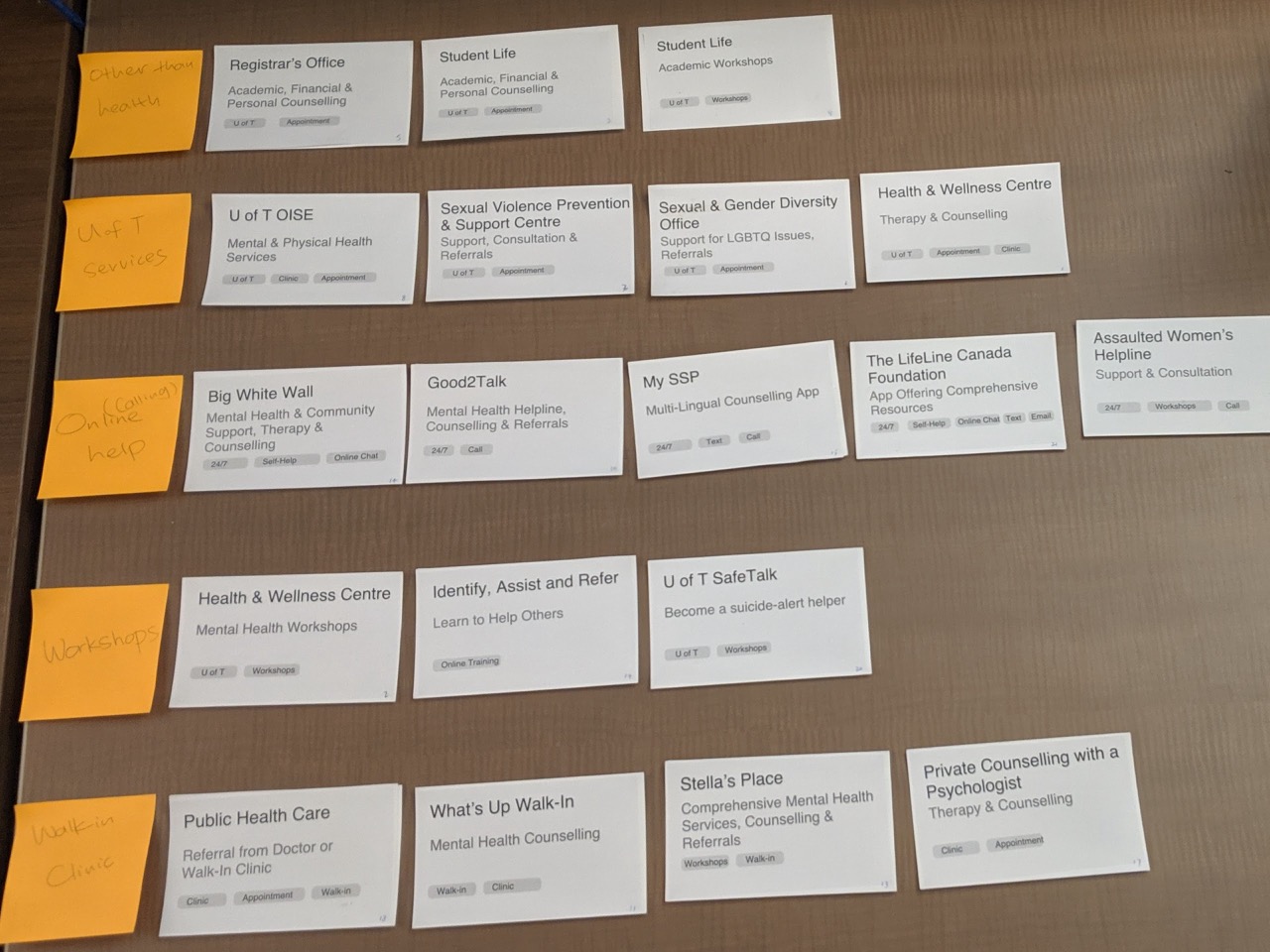
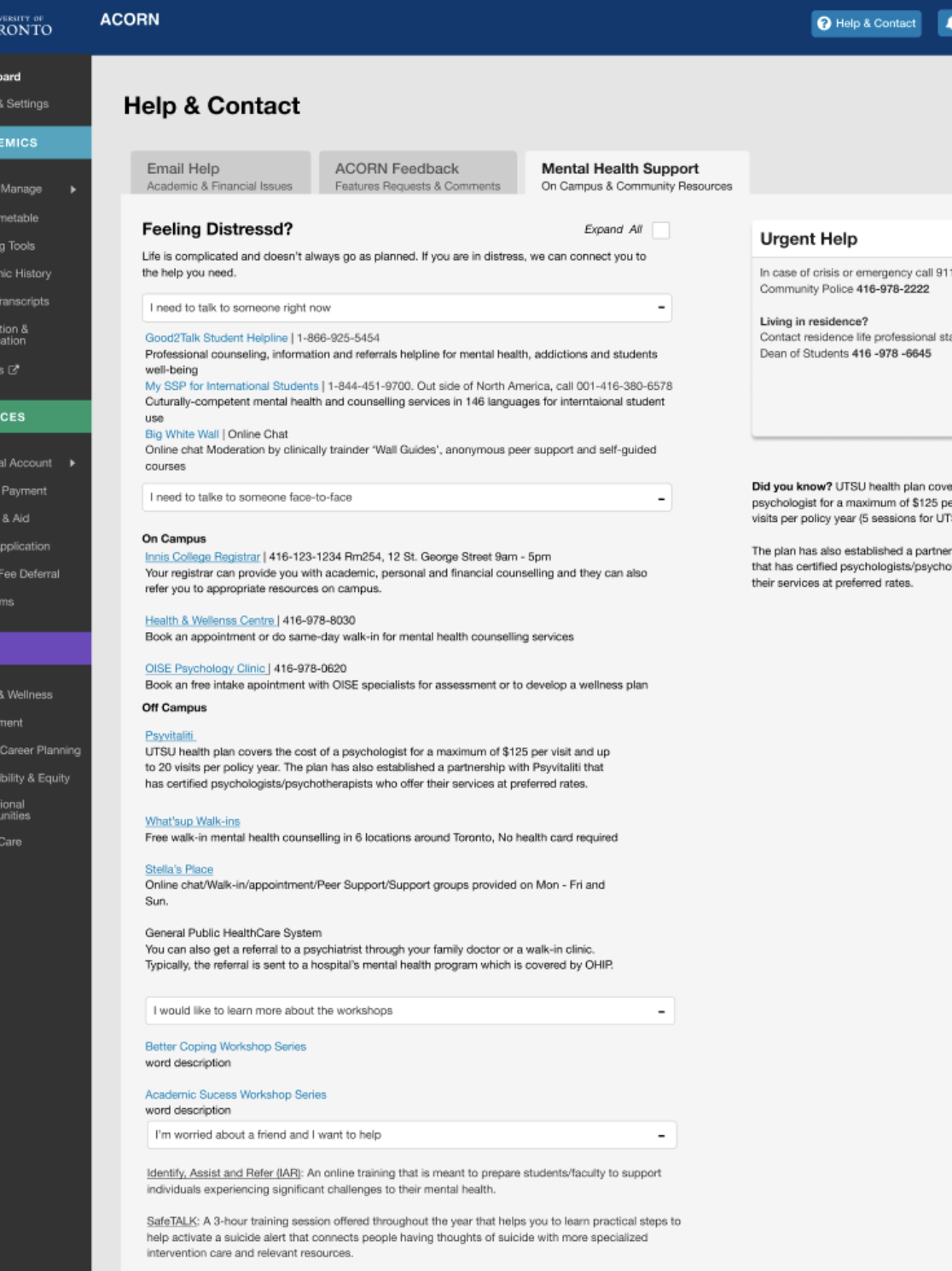
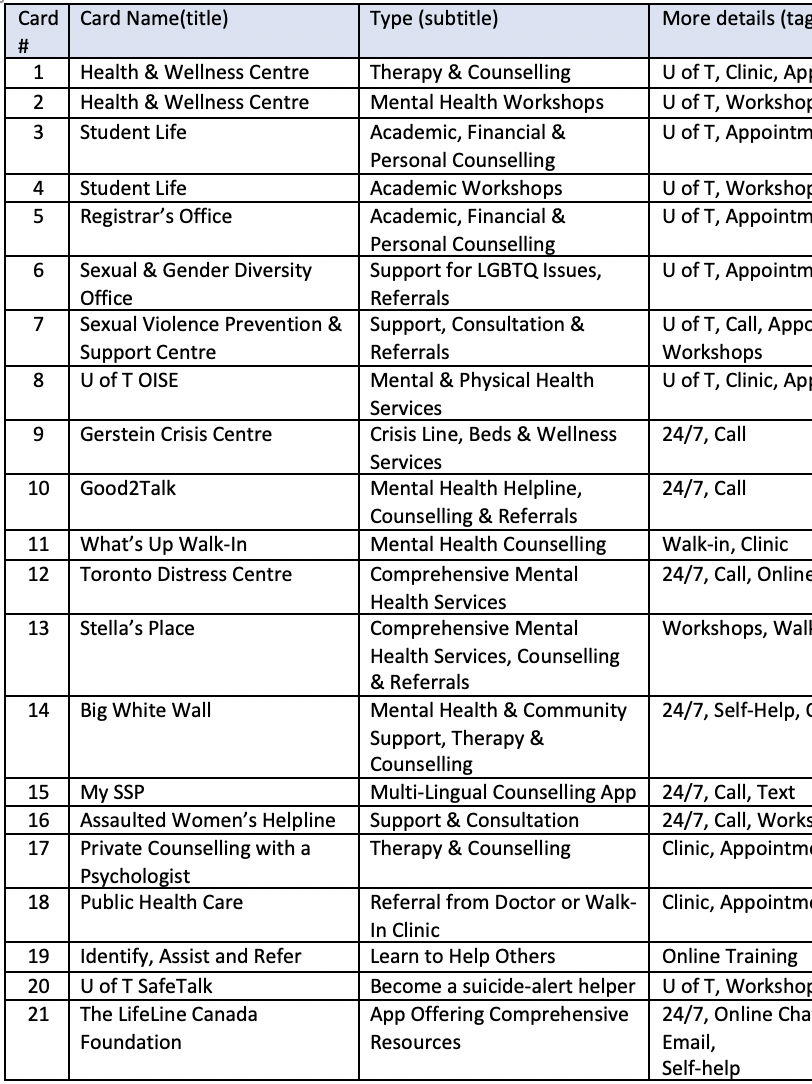
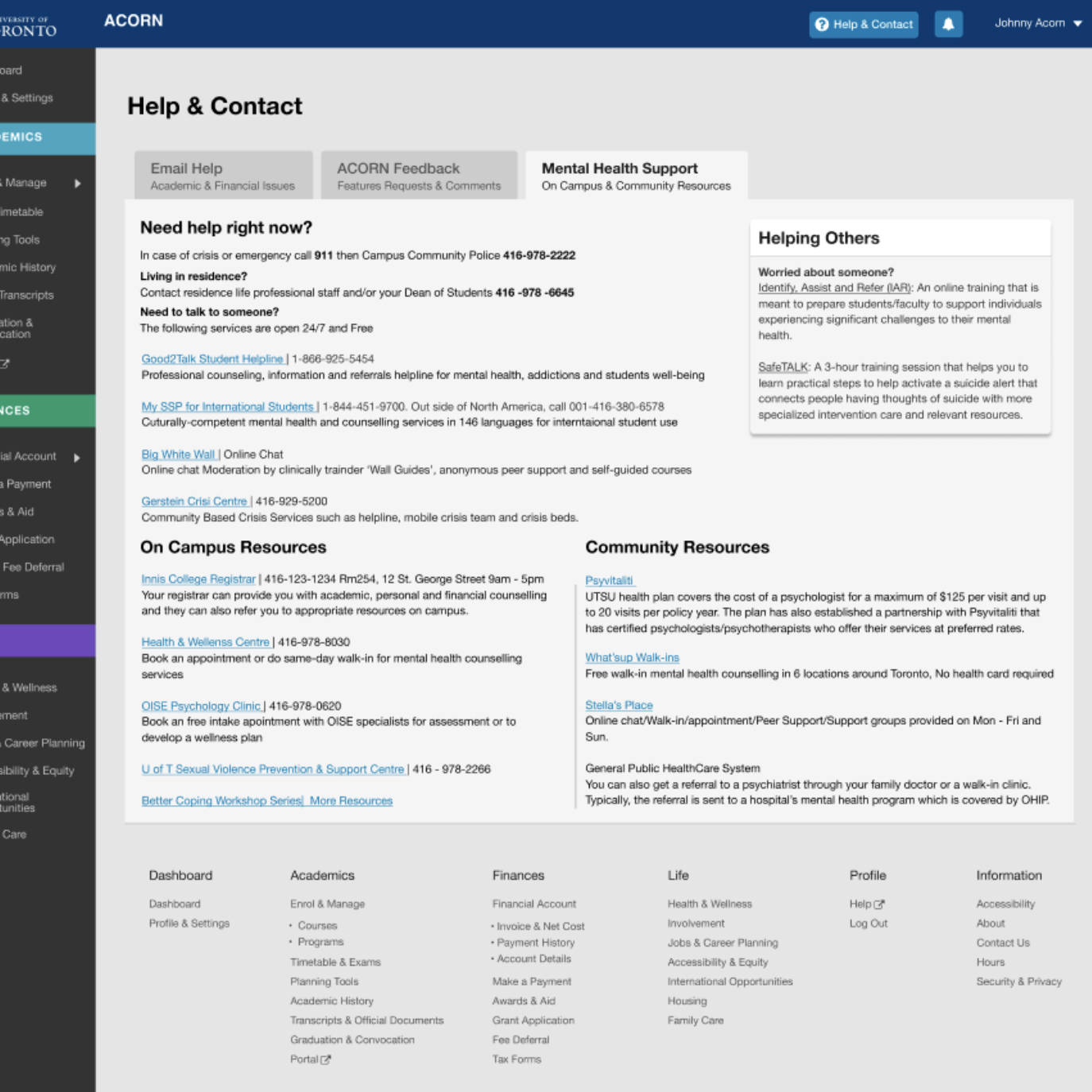
Situating supports: Early research findings and design activities
Our initial research established that students felt uncertain about what resources were available to them and overwhelmed by exhaustive lists (i.e. of all topics, for all students).
Many students expressed concerns about being stigmatized by the university if they sought out supports, informing privacy considerations in our designs and code implementation.
Additionally, we identified a desire of students to access relevant resources regarding peers about whom they were concerned.
These findings guided our information architecture of breaking down resources into intuitive, manageable categories.
Further design intention went into considering time-sensitivity and acuteness of distress. Above all else, urgent circumstances required immediate interventions and we were cognizant of that factor in how we presented actionable information.
Conceptually, I wanted resources to be close-to-hand throughout ACORN. But once presented, how to manage the large volume and diversity of existing resources? How to personalize all this?
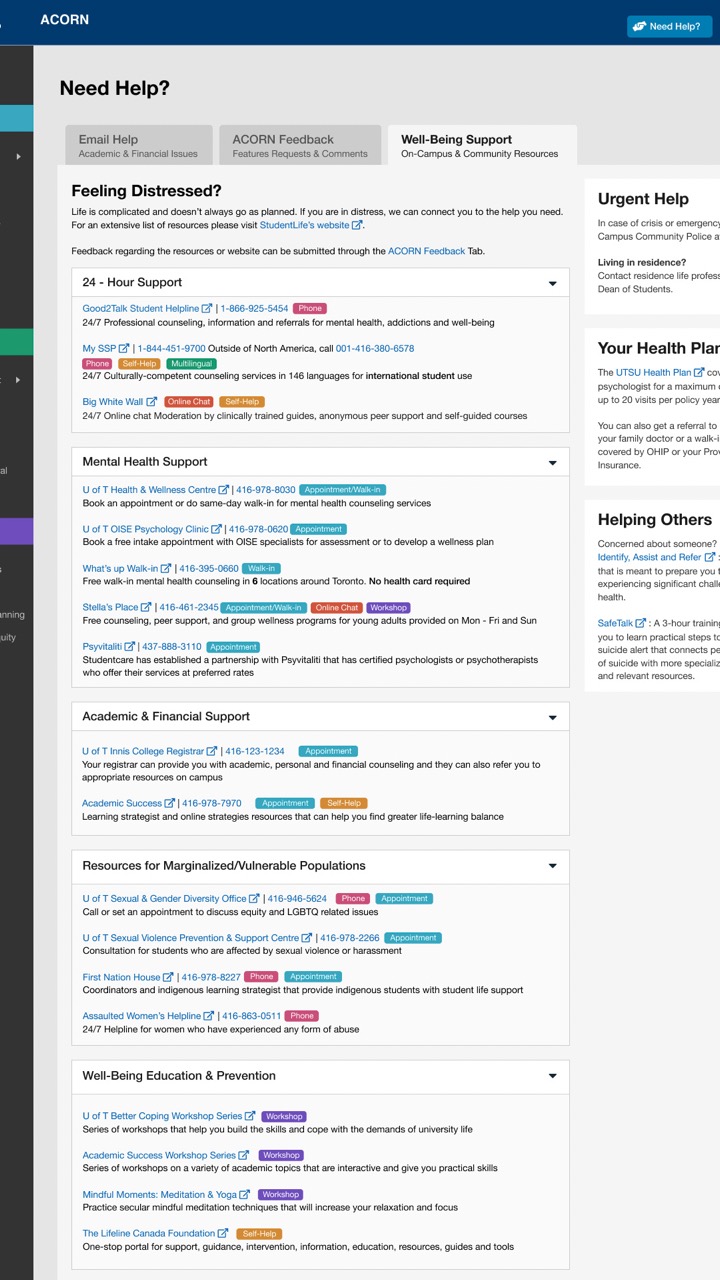
1. A tagging system evolved from student feedback during our earliest usability testing sessions, team working sessions and critiques, to aid in scanning and selecting for certain kinds of services/delivery models.
To best present a range of supports invoked by a header “Need Help?” button, we explored different categorization, layout and interaction approaches informed by research with our Student Advisory Team members.
2. ACORN is an accessible responsive web and mobile platform, so mobile designs were developed concurrently with desktop. Careful positioning of ‘urgent’ content was a factor here.
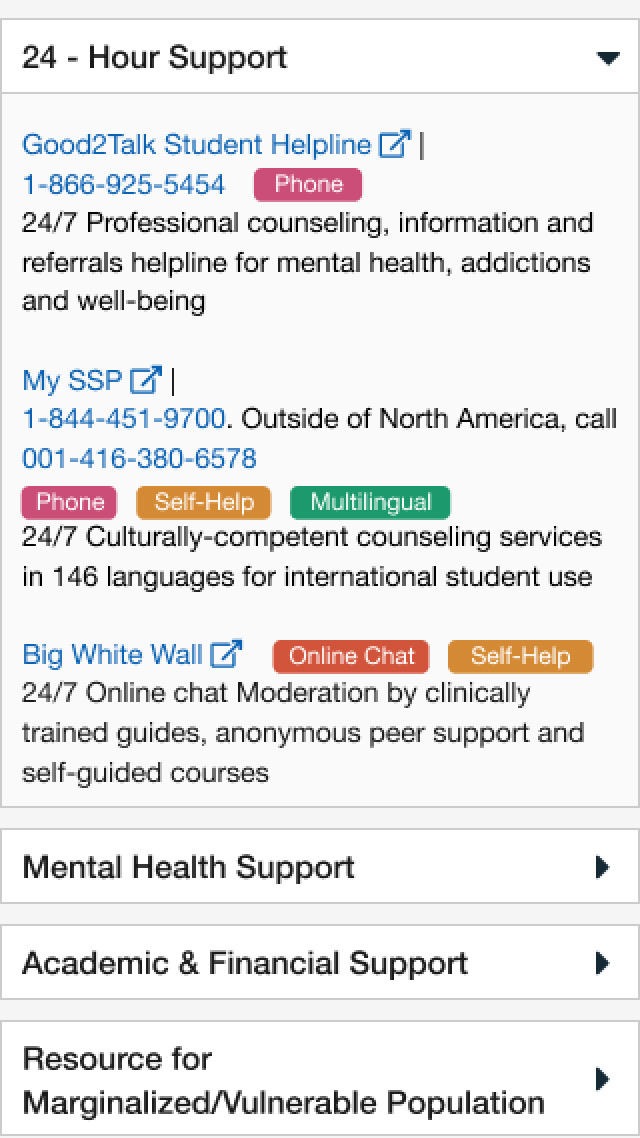
Personalizing supports: Designing better services delivery by leveraging known attributes to curate personalized resources
Effective curation was central to my idea for delivering personalized supports. This was accomplished via automated filtering out of irrelevant resources via student registration-based information and providing data relevant to a student’s attributes.
From known attributes, we were able to programmatically determine a student’s likely health coverage, supports for their level of study, in-person services close to their campus, aspects of their financial status, and more, alongside other high-quality resources.
Some affiliations, however, for example, being registered with Accessibility Services, are confidential and by-design excluded from this area of ACORN, as was analytics tracking of outgoing links accessed by logged-in students here.
The following is an example of JSON data for a student, including their year of study, primary organization (i.e. campus), and financial status (this student has financial issues to be resolved).
{
"personId": 1000000000,
"registrationStatusList": [
{
"sqpda": null,
"sessionCode": "20221",
"registrationStatusCode": "REG",
"yearOfStudy": "4",
"primaryOrgCode": "ERIN"
}
],
"financialStatus": {
"accountBalance": 1331.18,
"accountStatusCode": "3",
"accountStatusDescr": "Transferred to External Collections (no s/c)",
"financialArrangementCode": null,
"financialArrangement": null,
"financialHoldsInstitutions": [
"Student Accounts"
],
"feesChangedBySubjectPost": null,
"postsWithFees": [],
"startSessionCd": null,
"endSessionCd": null,
"sessionDesc": ""
},
"studentHasFutureExams": false,
"financialStatuses": []
}It’s not an understatement to say that the entire university community came together in response to this crisis. I was proud to be part of those results with my team.
Results of this work: Immediate and long-term impacts
I expect ACORN’s impact was modest in comparison to the massive outpouring of support that students showed each other. The university also undertook major overhauls to the mental health services that are offered and their delivery.
For our part, we leveraged the unique capabilities of ACORN to thoughtfully provide a personalized curation of the community’s most effective resources for students at the location where they might feel a trigger for serious distress.
ACORN now connects students with supports for marginalized groups, concerned friends, and people who need someone to talk to at any hour of the day or night.
Beyond the impact of this design, my team’s ongoing collaborations with organizational partners extended our work and helped enhance that of others.
We shared our research findings with those who maintain resource collections, which helped those staff to overhaul those webpages (now with improved information architecture and usability enhancements implemented).
The Well-Being Support area in ACORN informed later work, e.g. the University’s mental health virtual assistant (chatbot) and the Office of Student Life’s master list of all campus resources.
An important team note
Wenqi Li was a UX Co-op Practitioner at the time of this case study and did fantastic work on this project. She produced many artefacts that appear in this case study. You should check out her work. She was overseen by Laura Klamot, an exceptional UX Designer with a creative mind who is a wonderful mentor of her team.

Wenqi Jiang
UX Co-op Practitioner
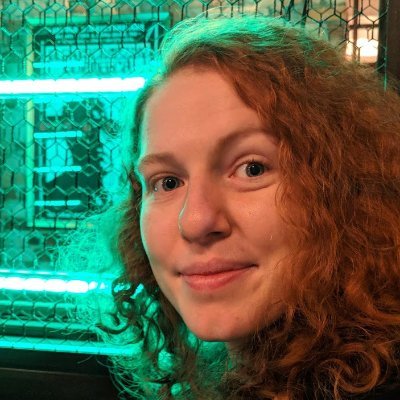
Laura Klamot
User Experience Designer